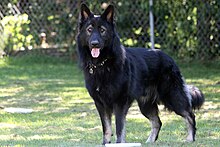This is an old revision of this page, as edited by Sagaciousphil (talk | contribs) at 12:47, 22 June 2015 (remove unreferenced). The present address (URL) is a permanent link to this revision, which may differ significantly from the current revision.
Revision as of 12:47, 22 June 2015 by Sagaciousphil (talk | contribs) (remove unreferenced)(diff) ← Previous revision | Latest revision (diff) | Newer revision → (diff)| This article relies excessively on references to primary sources. Please improve this article by adding secondary or tertiary sources. Find sources: "King Shepherd" – news · newspapers · books · scholar · JSTOR (July 2008) (Learn how and when to remove this message) |
| King Shepherd | |||||||||||||||||||||
|---|---|---|---|---|---|---|---|---|---|---|---|---|---|---|---|---|---|---|---|---|---|
 A male King Shepherd A male King Shepherd | |||||||||||||||||||||
| Origin | United States | ||||||||||||||||||||
| |||||||||||||||||||||
| Dog (domestic dog) | |||||||||||||||||||||
The King Shepherd is a dog breed developed from crossing German Shepherd Dog with Newfoundland as well as Shiloh Shepherd and long-coated European lines of German Shepherd in the 1990s.
Description
The King Shepherd is a large breed. Males stand at 29 to 32 inches (74 to 81 cm) tall and 100 to 150 pounds (45 to 68 kg) pounds while females are 25 to 29 inches (64 to 74 cm) tall and 75 to 110 pounds (34 to 50 kg).
The build of this dog is muscular, long, and robust; the structure is solid. The head is in good proportion with the body and moderately wide between the eyes. The forehead is slightly rounded. The cheeks are not too full and moderately curved when viewed from the top. The thick, firm ears are medium-sized and moderately wide at base. The eyes are medium-sized and almond shaped. The shades of the eyes can be varying shades of brown ranging from golden brown to almost black. The chest is broad and deep. Thickly feathered, the tail reaches at least to the hocks and is slightly curved. Docked tails are inadmissible. Paws are round and short with a well closed arch. The pads are very hard. The nails are short, strong, and dark-colored. Dewclaws are usually removed. The King Shepherd comes with a wide range of colors: Sable, black saddle with tan, gold, cream, and tan or silver markings. Pale washed-out colors are serious faults. The undercoat has little color except in solid black dogs. White, blue, or liver colored dogs or a dog with a nose that is other than black are not accepted in the show ring. Puppies change color until their final coat. There are two coat varieties - plush-haired and long-haired.
Temperament
The King Shepherd is self-confident with a well-balanced personality and healthy nervous system. They should not exhibit any shyness or nervousness. They are extremely intelligent, easy to train and eager and faithful to please their owners. This breed makes a fine sheep-herder and working dog. They are also a naturally courageous guard and watchdog, showing courage, strength, and hardiness in their role of protector. They make very nice companions and are friendly to other animals and children.
Care
King Shepherds are very intelligent and energetic, and needs both challenging mental stimulation and plenty of exercise. The King Shepherd takes well to strenuous activity.
Origin

Two American dog breeders Shelly Watts-Cross, and David Turkheimer created this large breed from the Shiloh Shepherd (American and European German Shepherd Dogs and Alaskan Malamutes), additional American-bred German Shepherd Dogs and the Great Pyrenees. An organized dog breed club was started in 1995.
Other information
The King Shepherd's life expectancy is 10–14 years. King Shepherds are classified in the herding group and have recognition by: ARBA, AKSC, WWKC, ERBDC, SKC, and the APRI.
References
- Walker, Joan. The Everything German Shepherd Book. F+W Publications. Retrieved 10 January 2013.
- "King Shepherd". American Rare Breed Association. January 1997. Retrieved 2011-07-23.
- Top Dog. DK Publishing. p. 36. Retrieved 10 January 2013.
- Buechert, Marian. "German Shepherd". Modern Dog Magazine. Retrieved 2011-07-23.